airbag Hyundai Sonata 2004 Owner's Manual
[x] Cancel search | Manufacturer: HYUNDAI, Model Year: 2004, Model line: Sonata, Model: Hyundai Sonata 2004Pages: 208, PDF Size: 16.93 MB
Page 10 of 208
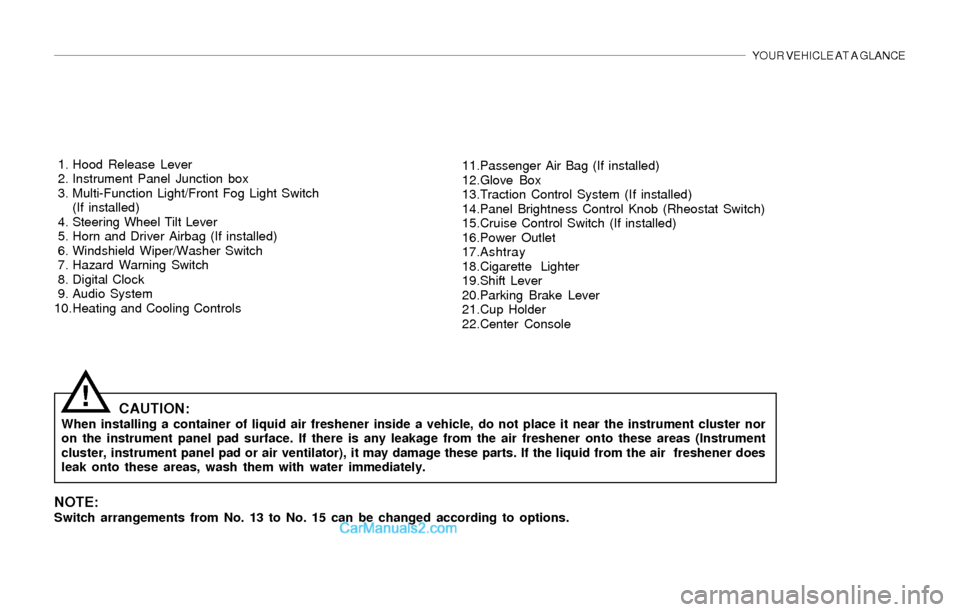
YOUR VEHICLE AT A GLANCE
1. Hood Release Lever
2. Instrument Panel Junction box
3. Multi-Function Light/Front Fog Light Switch
(If installed)
4. Steering Wheel Tilt Lever
5. Horn and Driver Airbag (If installed)
6. Windshield Wiper/Washer Switch
7. Hazard Warning Switch
8. Digital Clock
9. Audio System
10.Heating and Cooling Controls11.Passenger Air Bag (If installed)
12.Glove Box
13.Traction Control System (If installed)
14.Panel Brightness Control Knob (Rheostat Switch)
15.Cruise Control Switch (If installed)
16.Power Outlet
17.Ashtray
18.Cigarette Lighter
19.Shift Lever
20.Parking Brake Lever
21.Cup Holder
22.Center Console
CAUTION:When installing a container of liquid air freshener inside a vehicle, do not place it near the instrument cluster nor
on the instrument panel pad surface. If there is any leakage from the air freshener onto these areas (Instrument
cluster, instrument panel pad or air ventilator), it may damage these parts. If the liquid from the air freshener does
leak onto these areas, wash them with water immediately.
!
NOTE:Switch arrangements from No. 13 to No. 15 can be changed according to options.
Page 11 of 208
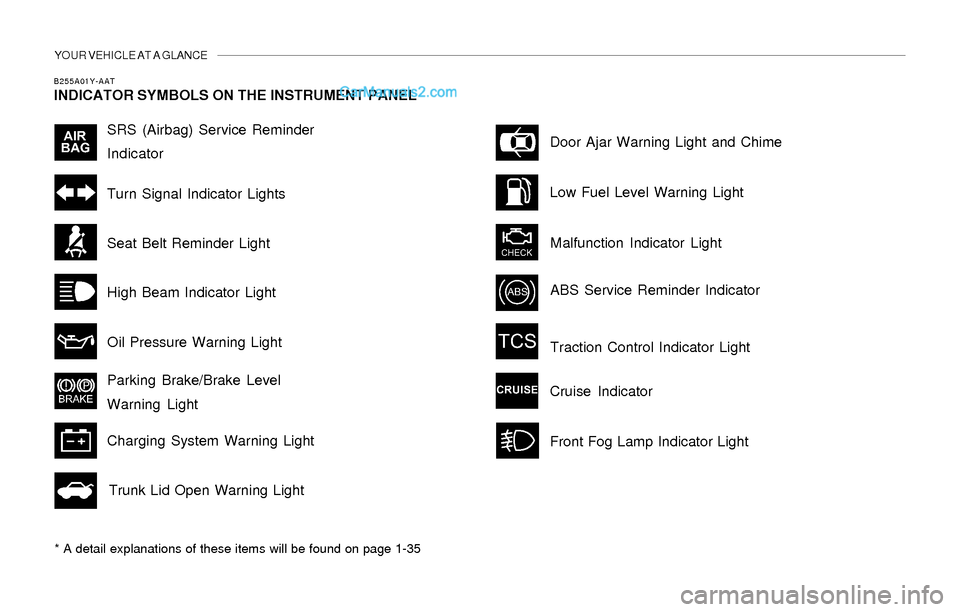
YOUR VEHICLE AT A GLANCE
B255A01Y-AAT
INDICATOR SYMBOLS ON THE INSTRUMENT PANEL
* A detail explanations of these items will be found on page 1-35
SRS (Airbag) Service Reminder
Indicator
Turn Signal Indicator Lights
High Beam Indicator Light
Oil Pressure Warning Light
Parking Brake/Brake Level
Warning Light
Charging System Warning Light
Trunk Lid Open Warning LightDoor Ajar Warning Light and Chime
Low Fuel Level Warning Light
Malfunction Indicator Light
Seat Belt Reminder Light
Traction Control Indicator Light
Cruise Indicator
ABS Service Reminder Indicator
Front Fog Lamp Indicator Light
Page 13 of 208
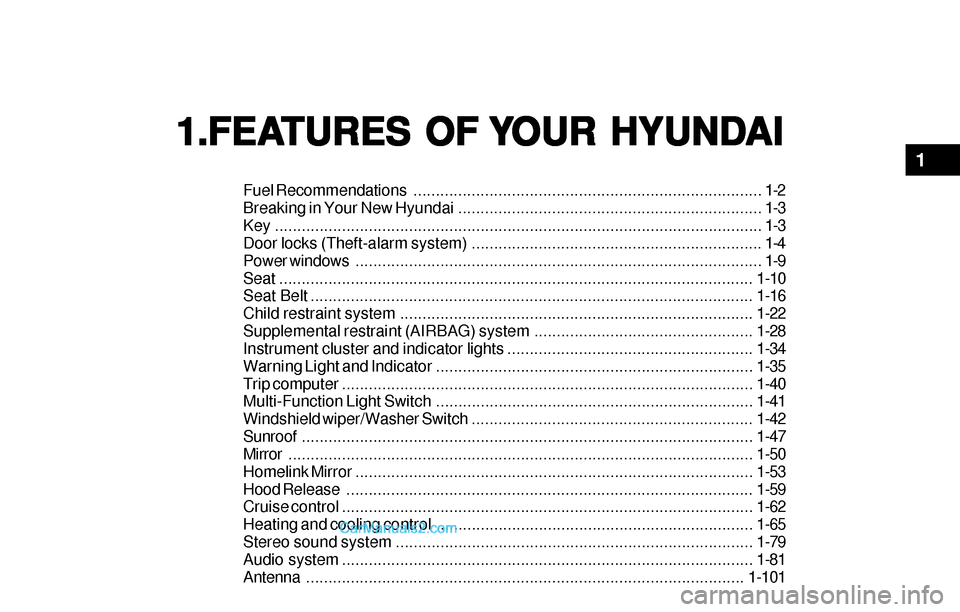
1.FEA 1.FEA1.FEA 1.FEA
1.FEA
TURES OF TURES OF TURES OF TURES OF
TURES OF
Y YY Y
Y
OUR HYUND OUR HYUNDOUR HYUND OUR HYUND
OUR HYUND
AI AIAI AI
AI
Fuel Recommendations.............................................................................. 1-2
Breaking in Your New Hyundai.................................................................... 1-3
Key ............................................................................................................. 1-3
Door locks (Theft-alarm system) ................................................................. 1-4
Power windows........................................................................................... 1-9
Seat..........................................................................................................1-10
Seat Belt...................................................................................................1-16
Child restraint system ...............................................................................1-22
Supplemental restraint (AIRBAG) system .................................................1-28
Instrument cluster and indicator lights.......................................................1-34
Warning Light and Indicator.......................................................................1-35
Trip computer............................................................................................1-40
Multi-Function Light Switch .......................................................................1-41
Windshield wiper/Washer Switch...............................................................1-42
Sunroof.....................................................................................................1-47
Mirror........................................................................................................1-50
Homelink Mirror.........................................................................................1-53
Hood Release...........................................................................................1-59
Cruise control............................................................................................1-62
Heating and cooling control .......................................................................1-65
Stereo sound system ................................................................................1-79
Audio system............................................................................................1-81
Antenna..................................................................................................1-101
1
Page 23 of 208
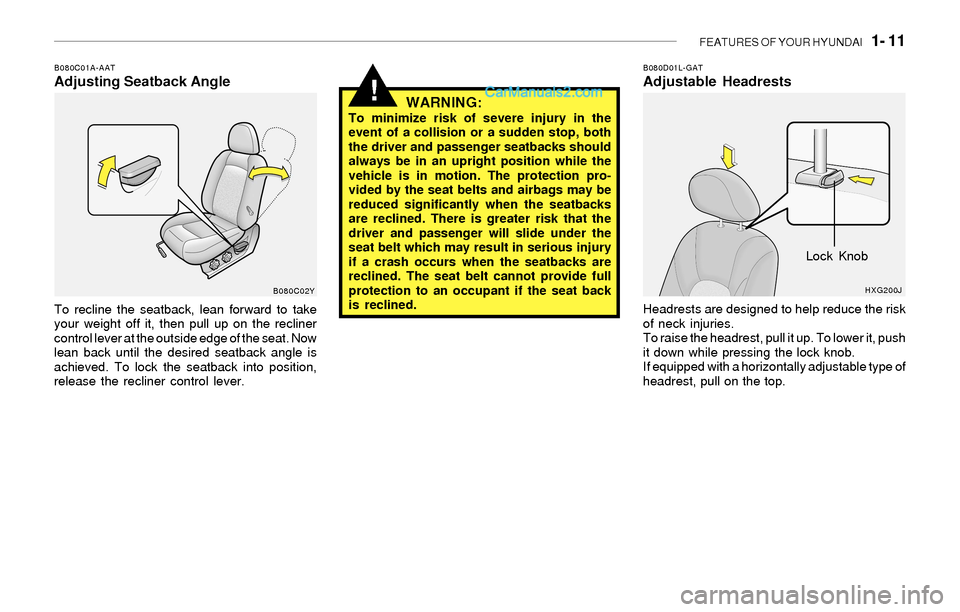
FEATURES OF YOUR HYUNDAI 1- 11
!
B080C01A-AATAdjusting Seatback Angle
To recline the seatback, lean forward to take
your weight off it, then pull up on the recliner
control lever at the outside edge of the seat. Now
lean back until the desired seatback angle is
achieved. To lock the seatback into position,
release the recliner control lever.
WARNING:To minimize risk of severe injury in the
event of a collision or a sudden stop, both
the driver and passenger seatbacks should
always be in an upright position while the
vehicle is in motion. The protection pro-
vided by the seat belts and airbags may be
reduced significantly when the seatbacks
are reclined. There is greater risk that the
driver and passenger will slide under the
seat belt which may result in serious injury
if a crash occurs when the seatbacks are
reclined. The seat belt cannot provide full
protection to an occupant if the seat back
is reclined.
B080D01L-GATAdjustable Headrests
Headrests are designed to help reduce the risk
of neck injuries.
To raise the headrest, pull it up. To lower it, push
it down while pressing the lock knob.
If equipped with a horizontally adjustable type of
headrest, pull on the top.
B080C02YHXG200J
Lock Knob
Page 25 of 208
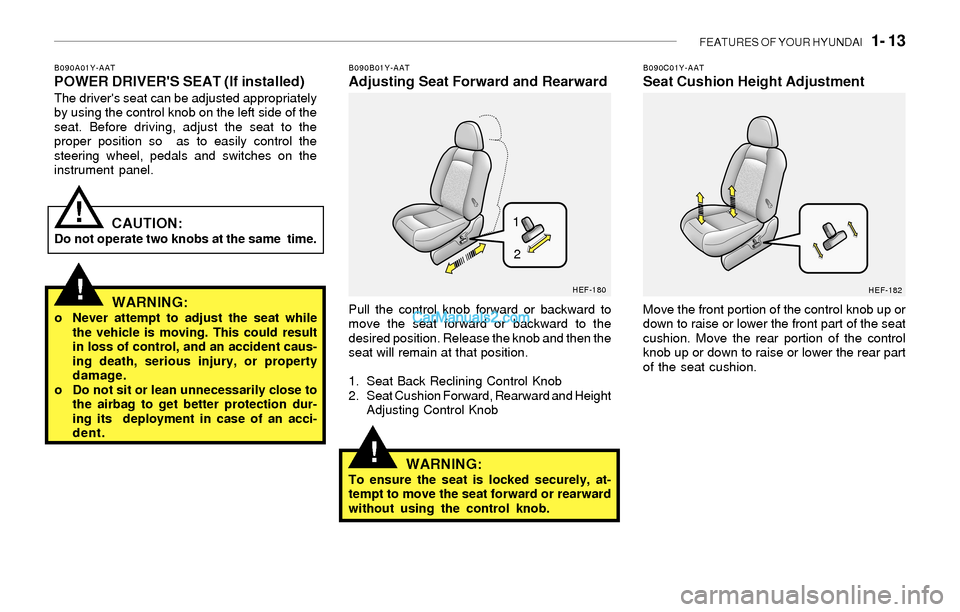
FEATURES OF YOUR HYUNDAI 1- 13
WARNING:o Never attempt to adjust the seat while
the vehicle is moving. This could result
in loss of control, and an accident caus-
ing death, serious injury, or property
damage.
o Do not sit or lean unnecessarily close to
the airbag to get better protection dur-
ing its deployment in case of an acci-
dent.
!
!
B090A01Y-AATPOWER DRIVER'S SEAT (If installed)The driver's seat can be adjusted appropriately
by using the control knob on the left side of the
seat. Before driving, adjust the seat to the
proper position so as to easily control the
steering wheel, pedals and switches on the
instrument panel.
CAUTION:Do not operate two knobs at the same time.
!
B090B01Y-AATAdjusting Seat Forward and Rearward
Pull the control knob forward or backward to
move the seat forward or backward to the
desired position. Release the knob and then the
seat will remain at that position.
1. Seat Back Reclining Control Knob
2. Seat Cushion Forward, Rearward and Height
Adjusting Control Knob
WARNING:To ensure the seat is locked securely, at-
tempt to move the seat forward or rearward
without using the control knob.
B090C01Y-AATSeat Cushion Height Adjustment
Move the front portion of the control knob up or
down to raise or lower the front part of the seat
cushion. Move the rear portion of the control
knob up or down to raise or lower the rear part
of the seat cushion.
HEF-180
HEF-182
1
2
Page 26 of 208
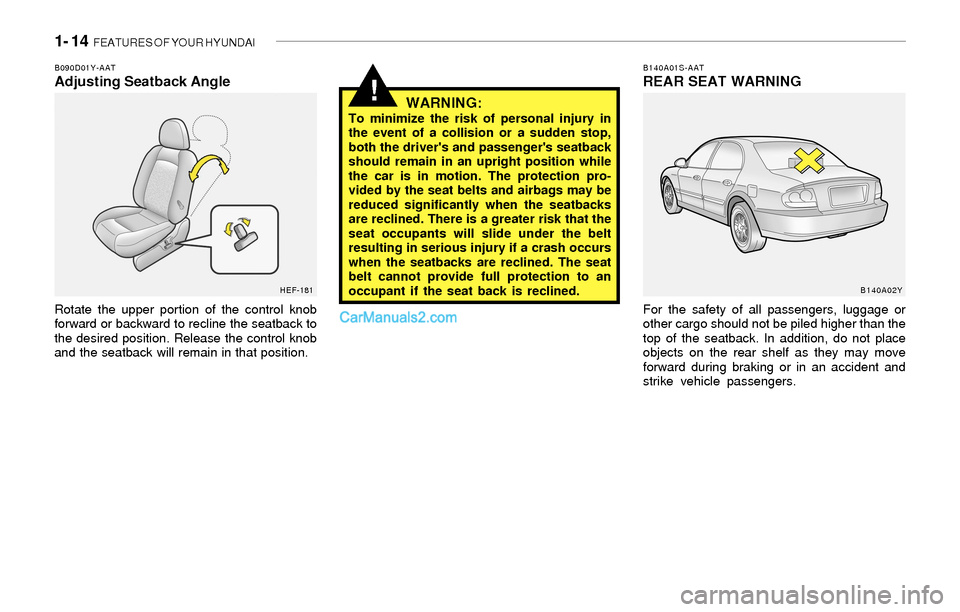
1- 14 FEATURES OF YOUR HYUNDAI
!
B090D01Y-AATAdjusting Seatback Angle
Rotate the upper portion of the control knob
forward or backward to recline the seatback to
the desired position. Release the control knob
and the seatback will remain in that position.
WARNING:To minimize the risk of personal injury in
the event of a collision or a sudden stop,
both the driver's and passenger's seatback
should remain in an upright position while
the car is in motion. The protection pro-
vided by the seat belts and airbags may be
reduced significantly when the seatbacks
are reclined. There is a greater risk that the
seat occupants will slide under the belt
resulting in serious injury if a crash occurs
when the seatbacks are reclined. The seat
belt cannot provide full protection to an
occupant if the seat back is reclined.
B140A01S-AATREAR SEAT WARNING
For the safety of all passengers, luggage or
other cargo should not be piled higher than the
top of the seatback. In addition, do not place
objects on the rear shelf as they may move
forward during braking or in an accident and
strike vehicle passengers.
HEF-181B140A02Y
Page 28 of 208
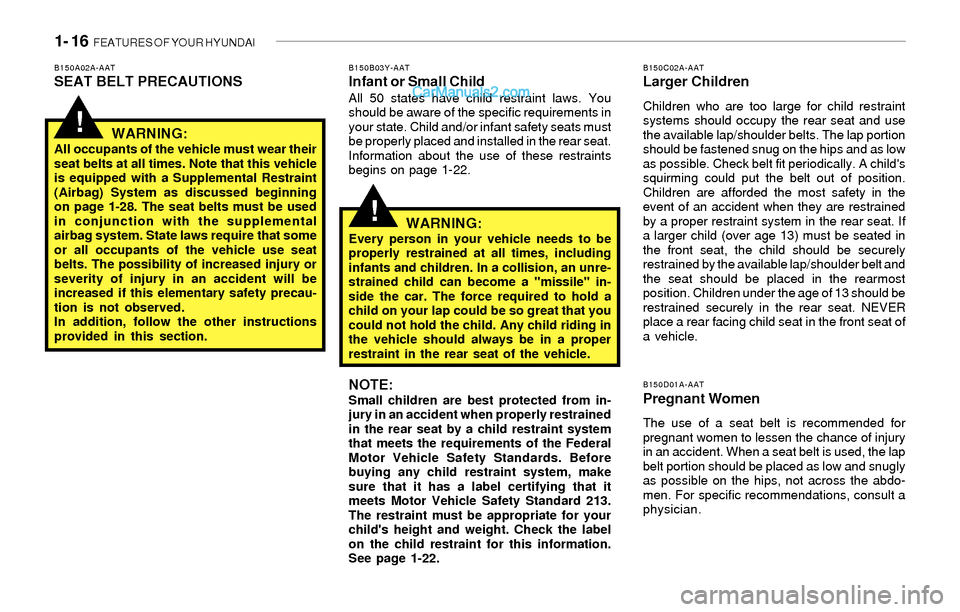
1- 16 FEATURES OF YOUR HYUNDAI
!
!
B150C02A-AATLarger Children
Children who are too large for child restraint
systems should occupy the rear seat and use
the available lap/shoulder belts. The lap portion
should be fastened snug on the hips and as low
as possible. Check belt fit periodically. A child's
squirming could put the belt out of position.
Children are afforded the most safety in the
event of an accident when they are restrained
by a proper restraint system in the rear seat. If
a larger child (over age 13) must be seated in
the front seat, the child should be securely
restrained by the available lap/shoulder belt and
the seat should be placed in the rearmost
position. Children under the age of 13 should be
restrained securely in the rear seat. NEVER
place a rear facing child seat in the front seat of
a vehicle.
B150D01A-AATPregnant Women
The use of a seat belt is recommended for
pregnant women to lessen the chance of injury
in an accident. When a seat belt is used, the lap
belt portion should be placed as low and snugly
as possible on the hips, not across the abdo-
men. For specific recommendations, consult a
physician.
B150A02A-AATSEAT BELT PRECAUTIONSB150B03Y-AATInfant or Small ChildAll 50 states have child restraint laws. You
should be aware of the specific requirements in
your state. Child and/or infant safety seats must
be properly placed and installed in the rear seat.
Information about the use of these restraints
begins on page 1-22.
WARNING:Every person in your vehicle needs to be
properly restrained at all times, including
infants and children. In a collision, an unre-
strained child can become a "missile" in-
side the car. The force required to hold a
child on your lap could be so great that you
could not hold the child. Any child riding in
the vehicle should always be in a proper
restraint in the rear seat of the vehicle.
NOTE:Small children are best protected from in-
jury in an accident when properly restrained
in the rear seat by a child restraint system
that meets the requirements of the Federal
Motor Vehicle Safety Standards. Before
buying any child restraint system, make
sure that it has a label certifying that it
meets Motor Vehicle Safety Standard 213.
The restraint must be appropriate for your
child's height and weight. Check the label
on the child restraint for this information.
See page 1-22.
WARNING:All occupants of the vehicle must wear their
seat belts at all times. Note that this vehicle
is equipped with a Supplemental Restraint
(Airbag) System as discussed beginning
on page 1-28. The seat belts must be used
in conjunction with the supplemental
airbag system. State laws require that some
or all occupants of the vehicle use seat
belts. The possibility of increased injury or
severity of injury in an accident will be
increased if this elementary safety precau-
tion is not observed.
In addition, follow the other instructions
provided in this section.
Page 34 of 208
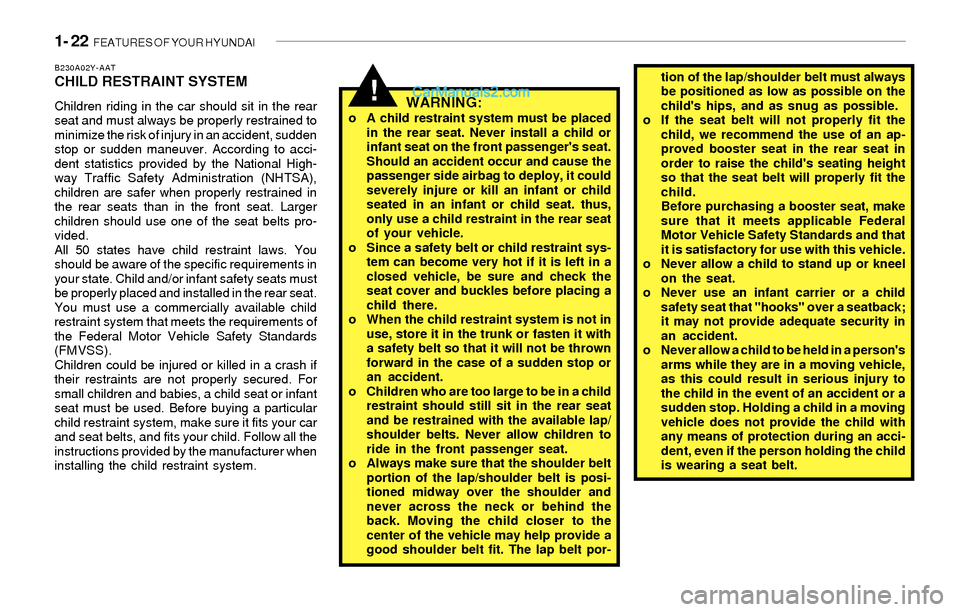
1- 22 FEATURES OF YOUR HYUNDAI
!
B230A02Y-AATCHILD RESTRAINT SYSTEM
Children riding in the car should sit in the rear
seat and must always be properly restrained to
minimize the risk of injury in an accident, sudden
stop or sudden maneuver. According to acci-
dent statistics provided by the National High-
way Traffic Safety Administration (NHTSA),
children are safer when properly restrained in
the rear seats than in the front seat. Larger
children should use one of the seat belts pro-
vided.
All 50 states have child restraint laws. You
should be aware of the specific requirements in
your state. Child and/or infant safety seats must
be properly placed and installed in the rear seat.
You must use a commercially available child
restraint system that meets the requirements of
the Federal Motor Vehicle Safety Standards
(FMVSS).
Children could be injured or killed in a crash if
their restraints are not properly secured. For
small children and babies, a child seat or infant
seat must be used. Before buying a particular
child restraint system, make sure it fits your car
and seat belts, and fits your child. Follow all the
instructions provided by the manufacturer when
installing the child restraint system.WARNING:o A child restraint system must be placed
in the rear seat. Never install a child or
infant seat on the front passenger's seat.
Should an accident occur and cause the
passenger side airbag to deploy, it could
severely injure or kill an infant or child
seated in an infant or child seat. thus,
only use a child restraint in the rear seat
of your vehicle.
o Since a safety belt or child restraint sys-
tem can become very hot if it is left in a
closed vehicle, be sure and check the
seat cover and buckles before placing a
child there.
o When the child restraint system is not in
use, store it in the trunk or fasten it with
a safety belt so that it will not be thrown
forward in the case of a sudden stop or
an accident.
o Children who are too large to be in a child
restraint should still sit in the rear seat
and be restrained with the available lap/
shoulder belts. Never allow children to
ride in the front passenger seat.
o Always make sure that the shoulder belt
portion of the lap/shoulder belt is posi-
tioned midway over the shoulder and
never across the neck or behind the
back. Moving the child closer to the
center of the vehicle may help provide a
good shoulder belt fit. The lap belt por-tion of the lap/shoulder belt must always
be positioned as low as possible on the
child's hips, and as snug as possible.
o If the seat belt will not properly fit the
child, we recommend the use of an ap-
proved booster seat in the rear seat in
order to raise the child's seating height
so that the seat belt will properly fit the
child.
Before purchasing a booster seat, make
sure that it meets applicable Federal
Motor Vehicle Safety Standards and that
it is satisfactory for use with this vehicle.
o Never allow a child to stand up or kneel
on the seat.
o Never use an infant carrier or a child
safety seat that "hooks" over a seatback;
it may not provide adequate security in
an accident.
o Never allow a child to be held in a person's
arms while they are in a moving vehicle,
as this could result in serious injury to
the child in the event of an accident or a
sudden stop. Holding a child in a moving
vehicle does not provide the child with
any means of protection during an acci-
dent, even if the person holding the child
is wearing a seat belt.
Page 36 of 208
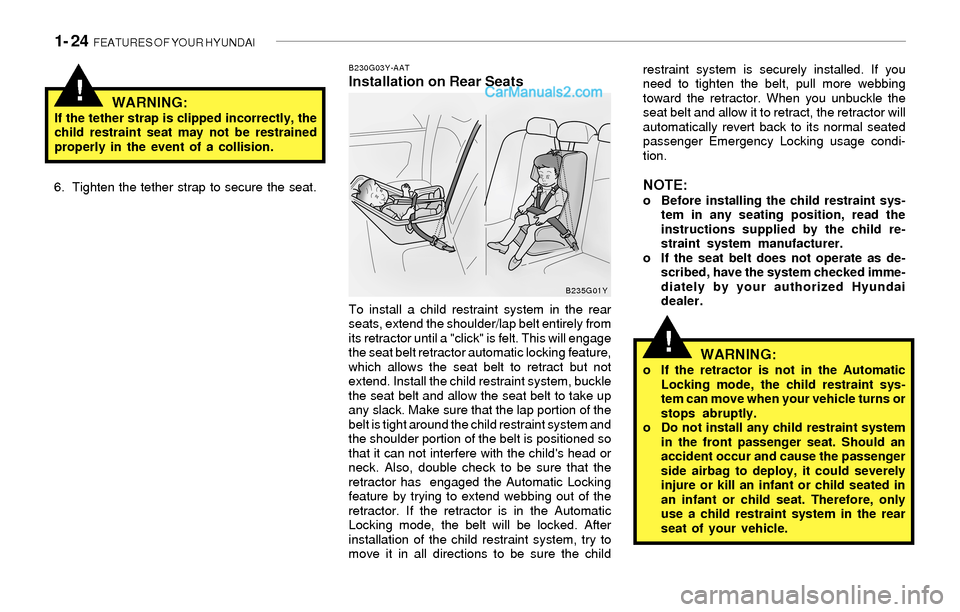
1- 24 FEATURES OF YOUR HYUNDAI
!
!
B230G03Y-AATInstallation on Rear Seats
WARNING:
If the tether strap is clipped incorrectly, the
child restraint seat may not be restrained
properly in the event of a collision.
6. Tighten the tether strap to secure the seat.
To install a child restraint system in the rear
seats, extend the shoulder/lap belt entirely from
its retractor until a "click" is felt. This will engage
the seat belt retractor automatic locking feature,
which allows the seat belt to retract but not
extend. Install the child restraint system, buckle
the seat belt and allow the seat belt to take up
any slack. Make sure that the lap portion of the
belt is tight around the child restraint system and
the shoulder portion of the belt is positioned so
that it can not interfere with the child's head or
neck. Also, double check to be sure that the
retractor has engaged the Automatic Locking
feature by trying to extend webbing out of the
retractor. If the retractor is in the Automatic
Locking mode, the belt will be locked. After
installation of the child restraint system, try to
move it in all directions to be sure the childrestraint system is securely installed. If you
need to tighten the belt, pull more webbing
toward the retractor. When you unbuckle the
seat belt and allow it to retract, the retractor will
automatically revert back to its normal seated
passenger Emergency Locking usage condi-
tion.
NOTE:o Before installing the child restraint sys-
tem in any seating position, read the
instructions supplied by the child re-
straint system manufacturer.
o If the seat belt does not operate as de-
scribed, have the system checked imme-
diately by your authorized Hyundai
dealer.
WARNING:o If the retractor is not in the Automatic
Locking mode, the child restraint sys-
tem can move when your vehicle turns or
stops abruptly.
o Do not install any child restraint system
in the front passenger seat. Should an
accident occur and cause the passenger
side airbag to deploy, it could severely
injure or kill an infant or child seated in
an infant or child seat. Therefore, only
use a child restraint system in the rear
seat of your vehicle.
B235G01Y
Page 38 of 208
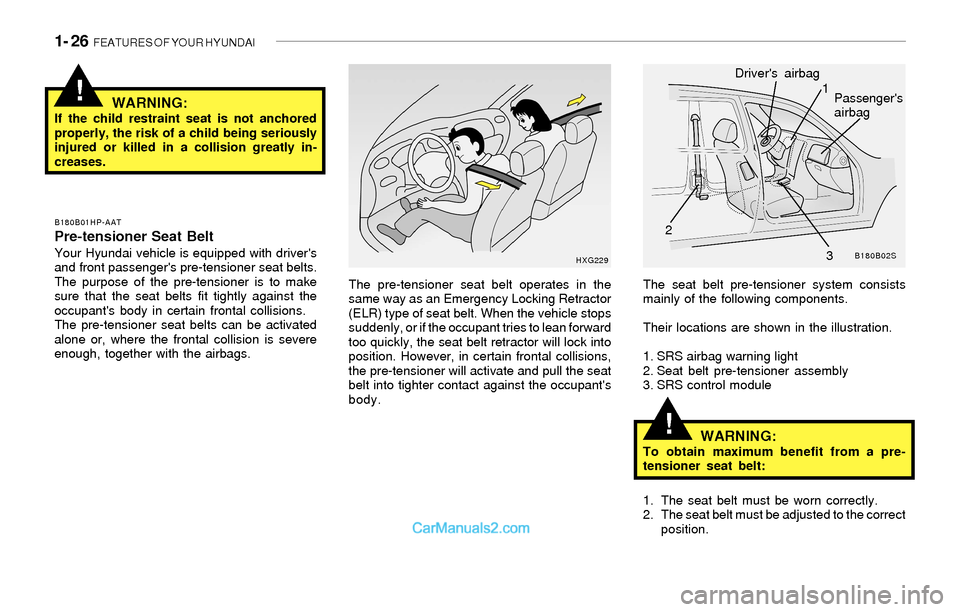
1- 26 FEATURES OF YOUR HYUNDAI
!
!WARNING:If the child restraint seat is not anchored
properly, the risk of a child being seriously
injured or killed in a collision greatly in-
creases.
The pre-tensioner seat belt operates in the
same way as an Emergency Locking Retractor
(ELR) type of seat belt. When the vehicle stops
suddenly, or if the occupant tries to lean forward
too quickly, the seat belt retractor will lock into
position. However, in certain frontal collisions,
the pre-tensioner will activate and pull the seat
belt into tighter contact against the occupant's
body.The seat belt pre-tensioner system consists
mainly of the following components.
Their locations are shown in the illustration.
1. SRS airbag warning light
2. Seat belt pre-tensioner assembly
3. SRS control module
B180B01HP-AATPre-tensioner Seat Belt
Your Hyundai vehicle is equipped with driver's
and front passenger's pre-tensioner seat belts.
The purpose of the pre-tensioner is to make
sure that the seat belts fit tightly against the
occupant's body in certain frontal collisions.
The pre-tensioner seat belts can be activated
alone or, where the frontal collision is severe
enough, together with the airbags.
WARNING:To obtain maximum benefit from a pre-
tensioner seat belt:
1. The seat belt must be worn correctly.
2. The seat belt must be adjusted to the correct
position.
HXG229B180B02S
1
2
3 Driver's airbag
Passenger's
airbag